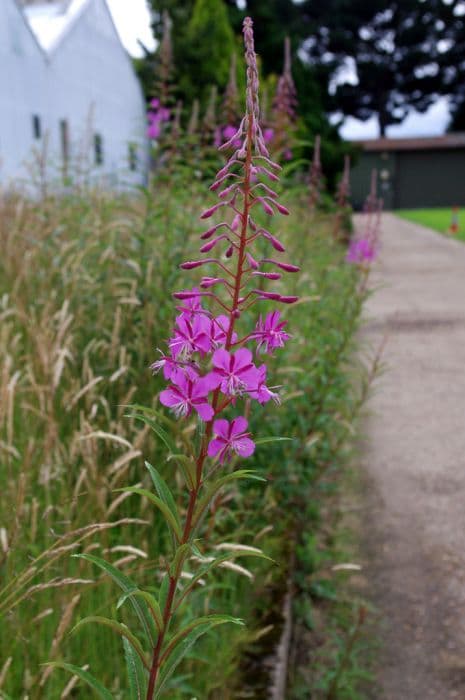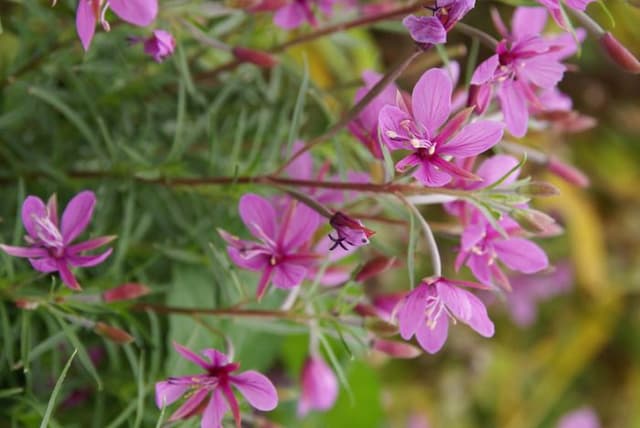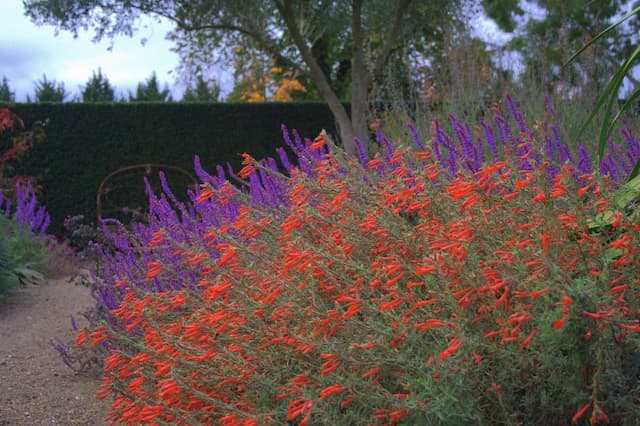Fuchsia Fuchsia 'Other Fellow'

ABOUT
The Fuchsia 'Other Fellow' is a striking ornamental plant known for its beautiful and distinctive flowers. The blooms of this plant hang gracefully from the stems, adding an elegant touch to any garden. These flowers have a unique two-tone appearance, typically featuring an outer layer of sepals that are long and slender with a gentle curve, often displaying a delicate pale color. Contrasting this are the inner petals which are usually vividly colored, creating a striking visual impact. The petals create an exquisite skirt-like form that dangles beneath the sepals, and together they provide a display reminiscent of dainty earrings. Furthermore, the Fuchsia 'Other Fellow' has deep green leaves that are slightly elongated with a subtle serration along the edges, providing a lush backdrop for the spectacular flowers. The foliage tends to cascade or grow with a slight droop, adding to the plant's graceful demeanor. These features contribute to the Fuchsia 'Other Fellow's popularity as a choice for hanging baskets or as a potted specimen that can be appreciated for its ornamental qualities. The overall effect of this plant, with its combination of striking blooms, elegant foliage, and gentle drooping habit, makes it a favored addition for gardeners looking to inject color and visual interest into their outdoor or indoor spaces.
About this plant
 Names
NamesFamily
Onagraceae.
Synonyms
Lady's Eardrops, Fairy Fuchsia, Hummingbird Fuchsia.
Common names
Fuchsia magellanica 'Other Fellow'.
 Toxicity
ToxicityTo humans
The common fuchsia plant, including the Fuchsia 'Other Fellow' variety, is generally considered non-toxic to humans. Ingesting parts of the plant typically does not result in poisoning or serious health consequences. However, sensitive individuals may experience mild gastrointestinal discomfort if they consume significant quantities of fuchsia plant parts.
To pets
For pets, the Fuchsia 'Other Fellow' is also generally regarded as non-toxic. Similar to humans, pets are unlikely to experience severe toxicity symptoms if they ingest parts of the fuchsia plant. While it is always best to prevent pets from eating non-food plants due to the potential for stomach upset, the common fuchsia does not pose a serious risk of poisoning to them.
 Characteristics
CharacteristicsLife cycle
Perennials
Foliage type
Deciduous
Color of leaves
Green
Flower color
Mixed
Height
2 feet [0.61 meters]
Spread
2 feet [0.61 meters]
Plant type
Shrub
Hardiness zones
9
Native area
Central America
Benefits
 General Benefits
General Benefits- Visual Appeal - Fuchsia 'Other Fellow' adds vibrant color and unique texture to gardens and landscapes with its attractive and distinctive flowers.
- Attracts Pollinators - The plant is known for attracting hummingbirds, butterflies, and other beneficial pollinators, which are essential for the health of your garden ecosystem.
- Container Gardening - Ideal for hanging baskets and containers due to its trailing growth habit, making it a versatile choice for patios and balconies.
- Shade Tolerance - It thrives in partial shade, providing a great option for garden areas that do not receive full sunlight.
- Long Blooming Period - Fuchsia 'Other Fellow' offers a lengthy blooming season, providing continuous color from late spring through fall.
- Easy Propagation - Can be easily propagated from cuttings, allowing gardeners to create more plants for other areas of their garden or to share with friends.
- Decorative Use - The unique flowers are frequently used in floral arrangements and can be a delicate addition to home decor when used as cut flowers.
 Medical Properties
Medical PropertiesThis plant is not used for medical purposes.
 Air-purifying Qualities
Air-purifying QualitiesThis plant is not specifically known for air purifying qualities.
 Other Uses
Other Uses- Decorative ice cubes: Freeze Fuchsia flowers in ice cube trays to create beautiful and unique ice cubes for punch bowls or drinks at garden parties.
- Nature-inspired art: Press Fuchsia flowers to create floral art pieces or use them as inspiration for botanical drawings and paintings.
- Garden markers: Use dried Fuchsia stems to mark rows and sections in your vegetable or herb garden, adding a touch of whimsy.
- Floral dye: Extract dye from the petals of Fuchsia flowers to color fabrics, yarns, or handmade paper.
- Plantable gift wrap: Incorporate Fuchsia flowers into biodegradable seed paper for an eco-friendly gift wrapping option that can be planted later.
- Hair accessories: Use fresh or dried Fuchsia flowers to create natural, decorative hair pins or barrettes for special occasions.
- Table confetti: Scatter dried Fuchsia petals on tables for a vibrant, nature-themed decoration at an event or celebration.
- Floral bookmarks: Laminate small Fuchsia blooms to create unique bookmarks for book lovers and garden enthusiasts.
- Homemade potpourri: Mix dried Fuchsia flowers with other fragrant botanicals to create natural potpourri for freshening up home spaces.
- Garden-themed crafts: Use Fuchsia flowers in DIY projects like flower pounding, where the natural pigments of the flowers are transferred onto fabric or paper to create interesting patterns.
Interesting Facts
 Feng Shui
Feng ShuiThe Fuchsia is not used in Feng Shui practice.
 Zodiac Sign Compitability
Zodiac Sign CompitabilityThe Fuchsia is not used in astrology practice.
 Plant Symbolism
Plant Symbolism- Confiding Love: Fuchsia's delicate hanging blooms are often seen as symbols of confiding love, indicating a deep emotional connection that is expressed with trust and confidence.
- Elegance and Good Taste: With its elegant flowers and graceful appearance, fuchsia often represents sophistication and a good sense of aesthetics, appreciated for its beauty in gardens and arrangements.
- Ardent Affection: The vibrant colors and abundant flowers of the fuchsia plant can signify a heartfelt and passionate affection towards someone.
 Water
WaterFuchsias, including 'Other Fellow', should be watered thoroughly whenever the top inch of soil feels dry to the touch, which can vary but is often about twice a week. It is important to avoid letting the soil dry out completely but also to not overwater, which can lead to root rot. When watering, it is best to use a gentle stream to soak the soil around the roots. Depending on the size of your container, a starting point might be around 16 to 32 ounces of water per watering, adjusting as needed based on weather and the plant's response. During hot summer days, watering may need to be more frequent due to increased evaporation.
 Light
LightFuchsias, such as 'Other Fellow', thrive in bright but indirect light. They do best in a location where they are protected from the intense midday sun, such as an east or north-facing window indoors or a shaded spot outdoors. Morning sun is beneficial, but strong afternoon rays can be too harsh and may harm the plant. Dappled sunlight beneath a canopy of trees is ideal for outdoor fuchsias.
 Temperature
TemperatureFuchsias, like 'Other Fellow', prefer cool temperatures, ideally between 55-75 degrees Fahrenheit. They can withstand temperatures down to around 40 degrees, but cold snaps below this can harm the plant. During hot weather, if temperatures rise above 76 degrees, it is crucial to provide adequate shade and water to keep fuchsias healthy. They are not tolerant of extreme heat or frost.
 Pruning
PruningPruning fuchsias like 'Other Fellow' is important for maintaining a compact shape and encouraging bushier growth. It should be done in late winter or early spring before the new growth starts. Remove any dead or weak branches, and pinch back the tips to promote branching. Pruning may also be done throughout the growing season to remove faded flowers and berries, which encourages further blooming.
 Cleaning
CleaningAs needed
 Soil
SoilFuchsia 'Other Fellow' or commonly known as Ladies' Eardrop performs best in a soil mix consisting of loam, peat moss, and perlite or sand which ensures good drainage and aeration. The ideal soil pH for Ladies' Eardrops should be slightly acidic to neutral, ranging from 6.0 to 7.0.
 Repotting
RepottingLadies' Eardrops should be repotted every two to three years to refresh the soil and to accommodate root growth. It's best to repot in spring before new growth begins.
 Humidity & Misting
Humidity & MistingLadies' Eardrops thrive in high humidity environments; maintaining humidity levels around 60-70% is ideal for this plant.
 Suitable locations
Suitable locationsIndoor
Keep in bright, indirect light and away from drafts.
Outdoor
Hang in dappled shade; shelter from strong winds.
Hardiness zone
10-11 USDA.
 Life cycle
Life cycleThe Fuchsia 'Other Fellow', commonly known as Fuchsia, begins its life cycle when a seed germinates, typically in warm and moist soil conditions. The seedling emerges and develops true leaves, entering the vegetative growth stage where it focuses on leaf and stem growth. During the flowering stage, the plant produces distinctive hanging flowers with a combination of pink, purple, and white hues attracting pollinators. After pollination, the flowers develop into small, dark-colored fruits that contain seeds, completing the reproductive phase. If environmental conditions are not favorable, or at the end of the growing season, the Fuchsia may enter a period of dormancy, where growth slows down or stops and the plant may lose its leaves. With the arrival of favorable conditions, such as warmer temperatures and increased daylight, the Fuchsia exits dormancy, resuming growth and preparing for another cycle of flowering and seed production.
 Propogation
PropogationPropogation time
Spring-Early Summer
Propogation: The Fuchsia 'Other Fellow', commonly known as Fuchsia, can be propagated mainly through softwood cuttings. This popular method involves taking a cutting from new growth that is not yet hardened, typically in late spring or early summer. To do this, a healthy stem about 3-5 inches (approximately 7.5-12.5 cm) long is cut just below a leaf node, where the concentration of growth hormones is high. Any leaves on the lower half of the stem are removed, and the cut end is dipped in a rooting hormone to facilitate root growth. The cutting is then planted in a mixture of peat and perlite to provide good drainage and moisture retention. The pot should be kept in a warm, humid environment with indirect light until roots develop, usually in about 3 to 4 weeks. Once rooted, the cutting can be potted up into a regular potting mix and grown on like any other Fuchsia plant.









